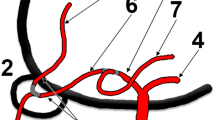Abstract
Objectives
The aim of this study was to investigate the incidence of a persistent primitive olfactory artery (POA) and to review the literatures focusing on the classification and clinical significance of this variant.
Design
To identify cases with persistent POA, we reviewed the records of computed tomography (CT) angiography performed on 3,067 patients in our institution from January 1, 2011 to August 31, 2013. Literatures on the incidence and classification of a persistent POA were reviewed.
Results
Among these patients, eight were diagnosed with a persistent POA (five men, three women, aged 44–82 years), an incidence of 0.26 %. Six persistent POAs terminated as a distal anterior cerebral artery (ACA) and two as a distal middle cerebral artery. Previous studies applied similar definitions for the classification of persistent POA; however, there has been confusion on the definition of variant 2.
Conclusion
In our institution, the incidence of persistent POA seen on CT angiography was 0.26 %. An artery with its embryological course along the olfactory bulb should be classified as a persistent POA and differentiated from dural artery from ACA.


Similar content being viewed by others
References
Ciolkowski M, Michalik R, Ciszek B (2004) Arteries to the proximal part of the olfactory tract. Folia Morphol Warsz 63:455–458
Enomoto H, Goto H, Murase M (1986) A ruptured cerebral aneurysm of the fronto-orbital artery and a coexisting anastomosis with the anterior ethmoidal artery—a case report. No Shinkei Geka 14:203–206
Hanakita J, Nagayasu S, Nishi S, Suzuki T (1988) An aneurysm of the distal anterior Cerebral artery with a remarkably anomalous configuration. No Shinkei Geka 16:781–784
Horie N, Morikawa M, Fukuda S, Hayashi K, Suyama K, Nagata I (2012) New variant of persistent primitive olfactory artery associated with a ruptured aneurysm. J Neurosurg 117:26–28
Kaneko T, Suetake K, Shinya T, Takeda M (1999) Persistent primitive olfactory artery: report of 5 cases. No Shinkei Geka 27:933–939
Kim MS (2013) Persistent primitive olfactory artery connected with middle cerebral artery: case report. Surg Radiol Anat. doi:10.1007/s00276-013-1147-8
Komiyama M (2012) Persistent primitive olfactory artery. Surg Radiol Anat 34:97–98
Kwon BR, Yeo SH, Chang HW, Kim MJ, Kim E, Kim MK, Cho HC, Kim HS, Lee SM (2012) Magnetic resonance angiography and CT angiography of persistent primitive olfactory artery: incidence and association rate with aneurysm in Korea. J Korean Soc Radiol 66:493–499
Martins C, Yasuda A, Campero A, Ulm AJ, Tanriover N, Rhoton A Jr (2005) Microsurgical anatomy of the dural arteries. Neurosurgery 56(2 Suppl):211–251
Nozaki K, Taki W, Kawakami O, Hashimoto N (1998) Cerebral aneurysm associated with persistent primitive olfactory artery aneurysm. Acta Neurochir Wien 140:397–401
Signorelli F, Scholtes F, Kauffmann C, McLaughlin N, Bojanowski MW (2010) Dural artery from the anterior cerebral artery to the planum sphenoidale. Acta Neurochir Wien 152:1807–1808
Tsuji T, Abe M, Tabuchi K (1995) Aneurysm of a persistent primitive olfactory artery. Case report. J Neurosurg 83:138–140
Tsutsumi S, Shimizu Y, Nonaka Y, Abe Y, Yasumoto Y, Ito M, Oishi H (2009) Arteriovenous fistula arising from the persistent primitive olfactory artery with dual supply from the bilateral anterior ethmoidal arteries. Neurol Med Chir Tokyo 49:407–409
Uchino A, Saito N, Kozawa E, Mizukoshi W, Inoue K (2011) Persistent primitive olfactory artery: MR angiographic diagnosis. Surg Radiol Anat 33:197–201
Vasovic L, Trandafilovic M, Vlajkovic S, Jovanovic I, Ugrenovic S (2013) Persistent primitive olfactory artery in serbian population. Biomed Res Int. doi:10.1155/2013/903460
Yamamoto T, Suzuki K, Yamazaki T, Tsuruta W, Tsurubuchi T, Matsumura A (2009) Persistent primitive olfactory artery aneurysm. Neurol Med Chir Tokyo 49:303–305
Yamaura A, Takase M, Makino H (1979) An aneurysm of the proximal anterior cerebral artery at the olfactory bulb. Surg Neurol 12:425–427
Acknowledgments
This work was supported by research grant from an Inje University College of Medicine.
Conflict of interest
We declare that we have no conflict of interest with any organization or institute.
Author information
Authors and Affiliations
Corresponding author
Rights and permissions
About this article
Cite this article
Kim, M.S., Lee, G.J. Persistent primitive olfactory artery: CT angiographic diagnosis and literature review for classification and clinical significance. Surg Radiol Anat 36, 663–667 (2014). https://doi.org/10.1007/s00276-013-1239-5
Received:
Accepted:
Published:
Issue Date:
DOI: https://doi.org/10.1007/s00276-013-1239-5




